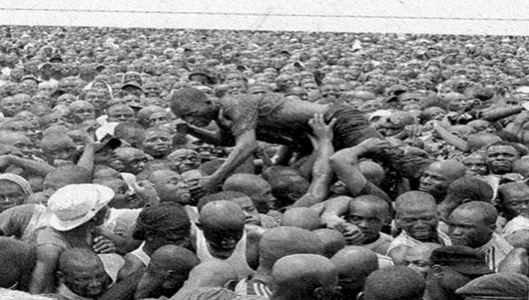Education, Knowledge and Evidence in the Post-2015 High-Level Panel Report: Utopian, Poetic or Technocratic? All Three! (Part 1)
PART I: From Utopia and Poesy to Reality
By Michel Carton, NORRAG.
[note: all page numbers refer to pages in the HLP report]

Support for strongman in Ivory Coast. Backers of Laurent Gbagbo in Abidjan on Monday seeking to join the army
“The powerful in today’s world can no longer expect to set the rules and go unchallenged.” (p.4)
“It is also unrealistic to think we can help another one billion people to lift themselves out of poverty … without making structural changes in the world economy.” (p.5)
“We need to build better data-collection systems, especially in developing countries. Without them, measuring the goals and targets set out here can become an undue and unfeasible burden.” (p.56)
Unfortunately, the first two excerpts from the Report are not sufficiently reflected in practical terms in the Report’s content to leave the door open to the possibility that discussions under way will go further than what seems to be a clear trend for post-2015 as reflected by the third excerpt: the establishment of a battery of instruments and techniques whose mainly quantitative, standardized and universal nature is supposed to guarantee objectivity in relation with political processes and decisions that are mainly political.
The basic occurrence analysis[1] that follows will support this point of view by highlighting the place occupied by the fields of education, training, knowledge, research and skills in the 40,000 words that make up the Report and by showing how education is dealt with. There is however a preliminary phase to this analysis: checking whether the unspecific positions expressed in the first two citations are reflected throughout the Report, and could consequently apply to the education domain. Unfortunately, this verification gives far from positive results if we look at the compared frequencies of the following general terms:
Poor 12, Rich 1: there are no poor without the rich! Is there not a relation between the concerns of the Report for growing inequalities and poverty, and the rise of the rich? Are they the powerful mentioned in the first citation?
Workers 13: they are usually of interest in connection with their working conditions and the relation between their income and their education/qualifications/skills levels. However, it does not seem to be the case here, considering the following occurrences: Wages 2, Salaries 0. The word Income appears 20 times but it is a very generic term covering any kind of monetary revenue and livelihood that can refer to Jobs as well as to Employment. We shall see next the radical difference in approach embedded in these two terms.
Jobs 33
Employment 1, Decent work 1
Youth employment 1: who will invest for the sake of young people if there are no “structural changes in the world economy”?
Youth unemployment 2: luckily, South America welcomes young Spaniards with open arms!
Growth 44
This is grounds for concern: can growth – even when it is inclusive, equitable, sustainable and green as presented by the High Level Panel report – enable the structural changes in the world economy (second citation) that the report calls for and which are indispensable for “eradicating” poverty as well as, consequently, conflicts? What is the difference between this virtuous growth, and the irresponsible growth in the 1950s to 1970s that led to the economic and financial crises on which the Panel barely touches?
From these figures it seems that jobs, the ones that are the title of the World Bank’s World Development Report 2013, have become the rule to re-launch growth at a time when employment – with all that that implies in terms of salaries, security and working conditions – is stagnating, which hurts in particular young people and the over-50s in the “developing” as well as in the “developed” countries. (To quote the out-dated categories used in the Report.) As the proposed vision of growth cannot be considered to be a structural change in the world economy, who will invest for the benefit of unemployed youth? And for a different vision of development?
More broadly be it in the formal, “informal” (five occurrences) or the precarious (The Precariat, Standing, 2011) sectors, work, in its values, organization and remuneration, is today experienced primarily as a constraint. Unfortunately, in spite of the reference made in the Report to the situation of some categories of unprivileged workers, there is no sign of reflection on the far-reaching changes in work which should lead to decent work and employment in a larger proportion than jobs (no occurrence of decent work, but 8 occurrences of decent jobs).
The domination of the words growth and jobs, in their mainstream way opposing the call for “structural changes in the world economy”, muddies the waters as to the credibility of the utopia conveyed by the first citation, as well as of the poetry, which the second holds out as a hope. It is surely by chance that the word should (72 occurrences in the text!) does not apply to the “making of structural changes in the world”!
How should education and training change after 2015? This will be dealt with in Part II of this blog post.
Michel Carton is the Executive Director of NORRAG. Email: michel.carton@graduateinstitute.ch
[1] The count refers only to words found in Chapters 1 to 5 and Annexe 1. It excludes references, notes, boxes and other annexes.

Pingback : Education, Knowledge and Evidence in the Post-2015 High-Level Panel Report: Utopian, Poetic or Technocratic? All Three! (Part 2) | NORRAG NEWSBite
Pingback : Education, Knowledge and Evidence in the Post-2015 High-Level Panel Report: Utopian, Poetic or Technocratic? All Three! (Part 3) | NORRAG NEWSBite